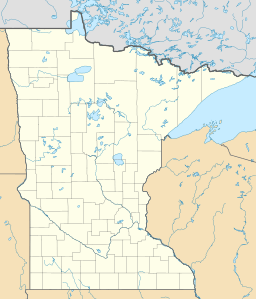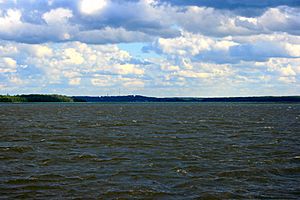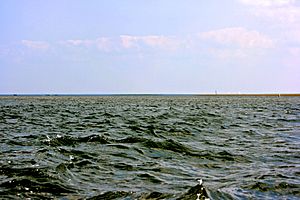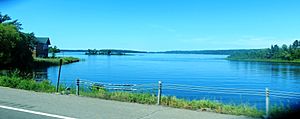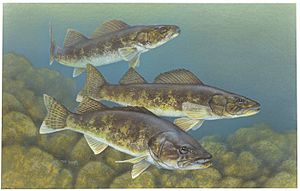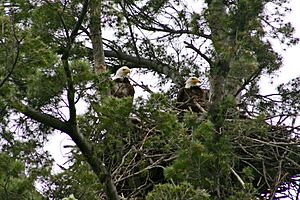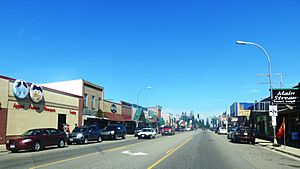Leech Lake facts for kids
Quick facts for kids Leech Lake |
|
|---|---|
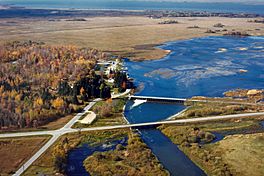
Lake and Dam
|
|
| Location | Chippewa National Forest, Cass County, Minnesota, U.S. |
| Coordinates | 47°09′21″N 94°23′24″W / 47.155755°N 94.389896°W |
| Primary outflows | Leech Lake River |
| Basin countries | United States |
| Surface area | 102,947.83 acres (41,661.51 ha) |
| Max. depth | 150 ft (46 m) |
| Shore length1 | 160.9 sq mi (417 km2) |
| Settlements | (see article) |
| 1 Shore length is not a well-defined measure. | |
Leech Lake is a large lake in north central Minnesota, United States. It is found southeast of Bemidji. Most of the lake is within the Leech Lake Indian Reservation. It is also completely inside the Chippewa National Forest. This lake is used as a reservoir to store water.
Leech Lake is the third largest lake in Minnesota. It covers about 102,947.83 acres (416.6151 km2) of water. The lake has 195 miles (314 km) of shoreline, which is like a very long beach! Its deepest point is about 156 feet (48 m) deep.
Contents
How Leech Lake Works: Hydrology
Leech Lake sends its water into the Leech Lake River. This river then flows into the famous Mississippi River. There is a special dam that controls how much water leaves the lake. This helps keep the lake's water level steady.
The lake gets its water from seven main streams. These include Portage Lake Creek, Sucker Creek, and the Boy River. There are also nine smaller streams that flow into Leech Lake.
Islands of Leech Lake
Leech Lake has eleven islands. Together, these islands cover about 1,617 acres of land. That's a lot of island space!
Here are the islands, from largest to smallest:
- Bear Island
- Minnesota Island
- Pelican Island
- Headquarters Bay Island
- Big Pipe Island
- Goose Island
- Bog (Duck) Island
- Narrows Island
- Little Bear Island
- Little Pelican Island
- Gull Island
- Shingobee Island
The long and narrow Shingobee Bay is part of Leech Lake. It is located at the southern end of the lake. Shingobee Bay and the nearby Walker Bay are some of the deepest spots in the entire lake.
Lake Life: Ecology
Unwanted Guests: Invasive Species
Invasive species are plants or animals that are not native to an area. They can cause harm to the environment.
- Purple Loosestrife (Lythrum salicaria)
This is an invasive plant that grows along the lake shores. It can take over areas where native plants like cattails usually grow. Purple loosestrife doesn't provide good food or homes for local animals. One plant can make about two million seeds each year, spreading very quickly.
- Narrow-leaf Cattail (Typha angustifolia)
This invasive cattail can grow in deeper water than native cattails. It competes with the native Typha latifolia (broad leaf cattail). It also competes with other native plants around Leech Lake.
Fish and Other Aquatic Animals
Leech Lake is a very popular spot for sport fishing. Many different kinds of fish live here. Some state records for fish were caught in Leech Lake in 1999. These include a 12-pound lake whitefish and a 1-pound pumpkinseed.
Here are some of the fish species you can find in the lake:
- Black crappie
- Bowfin (also called dog fish)
- Bluegill
- Brown bullhead
- Catfish
- Eelpout
- Hybrid sunfish
- Largemouth bass
- Muskellunge
- Northern pike
- Pumpkinseed
- Rock bass
- Smallmouth bass
- Tullibee (cisco)
- Walleye
- White sucker
- Yellow bullhead
- Yellow perch
- Jackfish
Plants in the Water: Vegetation
- Wild Rice
This important plant grows in the shallow parts of Leech Lake. It covers over 4,000 acres of water. Wild rice is a very valuable crop for the local Leech Lake community.
- Bulrush (Bulrush)
These are grass-like plants that grow in the water. They can grow up to ten feet tall. Bulrush plants are an important food source for the aquatic animals in Leech Lake.
Majestic Birds: Eagles
Leech Lake and the nearby national forest are home to many bald eagles. These amazing birds often return to the same nests year after year. The number of bald eagles has grown a lot over the past few decades.
A Look Back: History
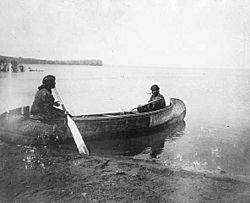
On old maps, Leech Lake was called "lac Sangsue" in French. This means "Bloodsucker Lake." This name was then translated into English as Leech Lake. The French name came from the Ojibwe name "Ozagaskwaajimekaag-zaaga'igan," which also means "lake abundant with bloodsuckers."
In 1855, the Leech Lake Indian Reservation was created on the south shore of Leech Lake. Over time, other reservations in the area joined together. In 1936, five reservations combined to form the larger Leech Lake Indian Reservation. This reservation now covers most of Leech Lake.
On October 5, 1898, a conflict happened at Leech Lake. It was between the Ojibwe people and soldiers from the United States. This event is known as the Battle of Sugar Point. A fight started when a soldier accidentally fired his rifle. This happened while soldiers were trying to find someone who was selling alcohol illegally. A soldier named Oscar Burkard later received the Medal of Honor for his bravery in this battle.
Fun and Business: Economy
Having Fun: Recreational Use
Every February, Leech Lake hosts a special event called the International Eelpout Festival. The eelpout, also known as the Burbot, is a fish rarely seen in the lake. But in winter, it becomes very common! The festival has fun activities like a fancy dinner and ice bowling. There's also a contest to catch the biggest eelpout.
Nearby Communities: Towns
Several towns and communities are located around Leech Lake:
- Leech Lake Township
- Remer
- Federal Dam
- Whipholt
- Walker
- Onigum
Images for kids
See also
 In Spanish: Lago Leech para niños
In Spanish: Lago Leech para niños


